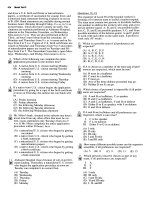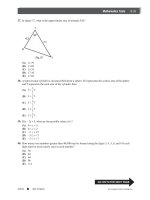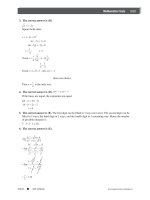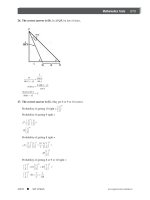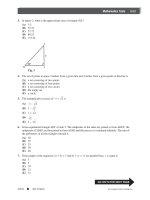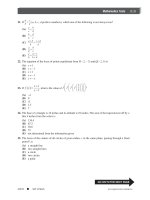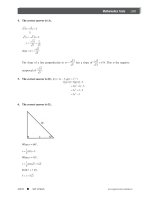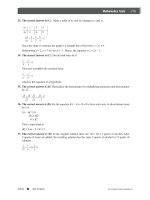SAT II History Episode 2 Part 6 pps
Bạn đang xem bản rút gọn của tài liệu. Xem và tải ngay bản đầy đủ của tài liệu tại đây (174.29 KB, 20 trang )
27. How many states were needed to ratify the
Constitution in order for it to become law?
(A) seven
(B) all thirteen states
(C) nine
(D) the four most populous states
(E) three quarters of the states
28. Passage of the Twelfth Amendment was a
direct result of the
(A) controversy that arose when the election
of 1824 was settled in the House of
Representatives
(B) difficulties that resulted from not having
separate presidential and vice presiden-
tial elections in the electoral college in
the election of 1800
(C) revolution of 1800
(D) one-man, one-vote system of the elec-
toral college
(E) loss of the 1888 presidential election by
Grover Cleveland to Benjamin Henry
Harrison
29. “We hold these truths to be self-evident; that
all men and women are created equal
Now, in view of this entire disfranchisement
of one half of the people of this country,
their social and religious degradation and
most fraudulently deprived of their most
sacred rights, we insist that they have
immediate admission to all the rights and
privileges which belong to them as citizens
of the United States.”
This was most probably written in behalf of
(A) free blacks
(B) enslaved blacks
(C) women
(D) Native Americans
(E) Mexicans in the Southwest
30. Division of labor in factories resulted in
(A) the manufacture of interchangeable parts
(B) the factory system
(C) mass production of goods
(D) the Bessemer steel process
(E) development of the electric dynamo
31. All of the following were results of the
Spanish-American War EXCEPT
(A) interest in having a U.S. naval presence
in the Pacific as well as the Atlantic
Ocean
(B) renewed interest in building a Panama
Canal
(C) establishment of a protectorate in Cuba
(D) the Supreme Court ruling that unincor-
porated possessions, such as Puerto
Rico, were not directed toward state-
hood
(E) the Monroe Doctrine was modified
32. In the election of 1912, Theodore Roosevelt
wanted Progressives to abandon which of the
following beliefs?
(A) The federal government should use its
resources to aid the needy.
(B) The federal government should strike
down all legal challenges to free-market
competition.
(C) The tariff system should be reformed to
aid workers.
(D) Monopolies are never in the public
interest.
(E) The federal government should prohibit
child labor through federal law.
➡
GO ON TO THE NEXT PAGE
PRACTICE TEST 2
PRACTICE TEST 2—Continued
275
Peterson’s n SAT II
Success: U.S. History www.petersons.com
33. All of the following were criticisms of the
nation’s banking and currency system before
enactment of the Federal Reserve Act
EXCEPT
(A) during crises, the banking system lacked
stability
(B) the amount of currency in circulation
was not pegged to the investment needs
of the country
(C) the money supply should be backed by
gold
(D) no central bank set banking practices
(E) Wall Street controlled too much bank
capital
34. The Howard-Wheeler or Indian Reorganiza-
tion Act was the LEAST successful in
(A) raising the living standards of Native
Americans
(B) restoring tribal ownership to those
reservation lands that had not been
divided into individual parcels
(C) returning local self-government to
nations who wished it
(D) ridding the reservations of squatters
(E) re-establishing traditional beliefs, crafts,
and customs
35. About of a third of the colonists were
Loyalists. A major reason for their desire to
maintain British rule was
(A) fear among the wealthy that law and
order would end with the end of British
control
(B) lack of belief in the Patriot cause
(C) fear of a slave revolt across the South
(D) fear by landowners of the loss of their
property
(E) fear of Native American attacks on
frontier settlements
36. The two-party political system in the United
States was primarily the result of
I. the fight over ratification of the Constitu-
tion waged by the Federalists and the
Anti-Federalists
II. conflicts in Congress over Hamilton’s
financial proposals
III. conflicts within Washington’s Cabinet
over Hamilton’s financial proposals
(A) I only
(B) II only
(C) III only
(D) I and II only
(E) II and III only
37. The most significant result of the invention
of the cotton gin was
(A) the mechanization of the process of
cleaning the raw cotton once it was
picked
(B) the increase in the slave trade
(C) an oversupply of cotton
(D) the increase in cotton agriculture
(E) the wearing out of the soil in the older
Southern states
38. Both the Force Bill and the Tariff Act of 1833
were passed to deal with the crisis that
developed over
(A) the Webster-Hayne Debate
(B) South Carolina’s Ordinance of Nullifica-
tion
(C) South Carolina Exposition, published
anonymously by John Calhoun
(D) Tariff of Abominations
(E) the Maysville Road veto
SAT II SUCCESS: U.S. HISTORY
PRACTICE TEST 2—Continued
276
Peterson’s n SAT II
Success: U.S. Historywww.petersons.com
39. The Kansas-Nebraska Act nullified part of the
(A) Compromise of 1850
(B) Great Compromise
(C) Wilmot Proviso
(D) Missouri Compromise
(E) Dred Scott decision
40. Which of the following is NOT an accurate
description of the Knights of Labor?
(A) The Knights championed the abolition of
child labor.
(B) Women, African Americans, and immi-
grants were admitted.
(C) The Knights were organized into
separate unions by crafts.
(D) Because of the Haymarket Riot, the
Knights became identified with radical-
ism.
(E) The Knights advocated arbitration rather
than strikes.
41. All of the following were “push” factors for
Southern and Eastern European immigrations
in the last half of the nineteenth century
EXCEPT
(A) tenant farms too small to support a
family
(B) financial panic and economic depression
(C) high tariffs on foodstuffs
(D) religious persecution
(E) industrial development
42. The significance of the Open Door Policy for
the United States lay in its
(A) providing a use for the Philippines as a
way station between China and the
United States
(B) moving the American public away from
isolationism and toward the view of the
nation as a world power
(C) keeping Japan from annexing Formosa
(D) guarantees from leasehold nations that
they would keep their Chinese ports
open to all nations
(E) obtaining the right to build a railroad in
China
43. The right to privacy was expanded in
(A) Heart of Atlanta v. United States
(B) Roe v. Wade
(C) Fourteenth Amendment
(D) Civil Rights Act of 1964
(E) Fair Credit Reporting Act of 1970
44. Why was the election of Ronald Reagan in
1980 of major significance?
(A) It demonstrated the importance of the
economy in presidential elections.
(B) It signaled a shift among voters to
conservatism.
(C) It reawakened interest in Richard
Nixon’s presidency.
(D) It was the first time a movie star had
been elected president.
(E) It showed a weariness with Jimmy
Carter’s leadership style.
➡
GO ON TO THE NEXT PAGE
PRACTICE TEST 2
PRACTICE TEST 2—Continued
277
Peterson’s n SAT II
Success: U.S. History www.petersons.com
45. Which of the following colonies established
the principle that local communities have a
duty under the law to establish schools?
(A) Rhode Island
(B) Connecticut
(C) Georgia
(D) Pennsylvania
(E) Massachusetts
46. The western boundary of British territory in
1763 in what would become the United
States was the
(A) Ohio River
(B) Pacific Ocean
(C) St. Lawrence River
(D) Mississippi River
(E) Lake Superior
47. The significance of the Annapolis Convention
lay in its
(A) agreement on uniform trade regulations
for the new states
(B) decision to send troops to end Shays’s
Rebellion
(C) ratification of the Northwest Ordinance
(D) decision to request another convention
to discuss the weaknesses of the Articles
of Confederation
(E) nomination of George Washington for
president
Questions 48 and 49 refer to the following
bar graph.
48. The drop in trade in 1808 can be
attributed to
(A) the Embargo Act
(B) the actions of the Barbary states
(C) Neutrality Proclamation
(D) Nonintercourse Act
(E) impressment of U.S. seamen
49. Which section would have suffered the most
from the decline in trade?
(A) Southern states
(B) New England
(C) frontier states
(D) Middle Atlantic states
(E) Old Northwest
U.S. FOREIGN TRADE, 1800–1812
250
225
200
175
150
125
100
75
50
25
0
(in millions of dollars)
Source: Historical Abstract of United States
1800
1801
1802
1803
1804
1805
1806
1807
1808
1809
1810
1811
1812
SAT II SUCCESS: U.S. HISTORY
PRACTICE TEST 2—Continued
278
Peterson’s n SAT II
Success: U.S. Historywww.petersons.com
50. “Fifty-four forty or fight!” was the rallying
cry of
(A) those who wanted to annex Texas
(B) proslavery supporters in Kansas
(C) supporters of the Oregon Territory
(D) Copperheads
(E) supporters of a larger area for the Indian
Territory
51. Agriculture prospered during the Civil War as
a result of all of the following EXCEPT
(A) rising prices for farm products
(B) the Homestead Act of 1862
(C) development of laborsaving machines,
such as the McCormick reaper
(D) expansion of railroads
(E) contraction of the money supply
52. The major reason for the economic rebuild-
ing of the South was
(A) high railway rates for freight
(B) the alliance between Southern business-
men and Northern financiers
(C) that Southern factory owners paid lower
wages than Northern owners
(D) the large number of African Americans
who were employed as sharecroppers
(E) the Supreme Court’s attitude toward
separate but equal accommodations
53. The Gilded Age can best be described as a
period of
(A) intense political activity by the presi-
dents
(B) political agitation by Western farmers
(C) labor unrest and combinations of
businesses
(D) unchecked use of the spoils system and
unregulated business competition
(E) laissez-faire attitude by government
toward business
54. “I stand for the square deal. But when I say
that I am for the square deal, I mean not
merely that I stand for fair play under the
present rules of the game, but that I stand
for having those rules changed so as to work
for a more substantial equality of opportunity
and of reward ”
The above statement was most likely the
words of
(A) Theodore Roosevelt
(B) Ronald Reagan
(C) Franklin Roosevelt
(D) Harry Truman
(E) John F. Kennedy
55. The most significant result of the Bonus
Army March was the
(A) passage in 1936 of a law allowing World
War I veterans to cash in their bonus
certificates nine years early
(B) show of support that veterans received
from the active army
(C) image it created of Hoover’s apparent
disregard for human suffering
(D) additional money the Reconstruction
Finance Corporation gave to state
governments for relief efforts
(E) demolition of the veterans’ Hooverville
56. An important work that contributed to the
awareness of the need for the “war on
poverty” was
(A) Michael Harrington’s The Other America
(B) Rachel Carson’s Silent Spring
(C) Ralph Nader’s Unsafe at Any Speed
(D) Hinton Helper’s The Impending Crisis in
the South
(E) John Kenneth Galbraith’s The Affluent
Society
➡
GO ON TO THE NEXT PAGE
PRACTICE TEST 2
PRACTICE TEST 2—Continued
279
Peterson’s n SAT II
Success: U.S. History www.petersons.com
57. Between 1820 and 1997, the largest number
of immigrants to the United States have been
(A) Irish
(B) German
(C) Mexican
(D) Italian
(E) Chinese
58. Both the Democrats and the Republicans
nominated presidential candidates in the
twentieth century who did not represent the
mainstream of political thought. Which of
the following pairs of candidates were
considered radical nominees by the majority
of Americans?
(A) Barry Goldwater and George McGovern
(B) Richard Nixon and Jimmy Carter
(C) Thomas Dewey and John F. Kennedy
(D) Richard Nixon and Lyndon Johnson
(E) George Bush and Lyndon Johnson
59. All of the following statements about colonial
politics are true EXCEPT
(A) the legislatures controlled taxes and
expenditures
(B) voting rights were limited to white male
property owners
(C) most colonies had bicameral legislatures
(D) each colony elected its own governor
(E) governors had limited authority
60. The weakening of the position of established
churches was a significant result of
(A) the splitting off of groups of Congrega-
tionalists into new churches
(B) the temperance movement
(C) transcendentalism
(D) the Great Awakening
(E) the opening of institutions of higher
education
61. The intent of the First Continental Congress
was primarily to
(A) stir up among the colonists the desire to
separate from Great Britain
(B) establish Committees of Correspondence
(C) oversee the conduct of the war
(D) revive the nonimportation agreements
(E) demand the colonists’ rights from Great
Britain within the framework of British
law and government
62. Which of the following is NOT true about
the election of 1828?
(A) Property qualifications for voting had
eased since the beginning of the nation
so that more men were able to vote in
1828 than in previous elections.
(B) Small farmers crossed sectional lines to
vote for Jackson.
(C) Jackson was the first president who was
not from the wealthy elite of the Eastern
seaboard.
(D) Jackson’s reputation as a self-made man
appealed to small business owners.
(E) Southern plantation owners did not vote
for Jackson because of a personal dislike
for the man.
63. In the presidential election of 1844, the
principal issue was
(A) the qualifications of James K. Polk
(B) manifest destiny
(C) slavery
(D) the annexation of Texas
(E) Clay’s refusal to promise to go to war
against Mexico
SAT II SUCCESS: U.S. HISTORY
PRACTICE TEST 2—Continued
280
Peterson’s n SAT II
Success: U.S. Historywww.petersons.com
Question 64 refers to the following map.
64. The four states shown on the map were
(A) the last four states to secede
(B) the so-called border states that remained in the Union
(C) the first four states to have reconstructed governments after
the war
(D) the only four states in which slaves were freed by the Emanci-
pation Proclamation
(E) states represented by Copperheads in Congress
➡
GO ON TO THE NEXT PAGE
Washington Territory
Unorganized
Territory
Nebraska Territory
Utah Territory
Kansas Territory
New Mexico Territory
Indian
Territory
PRACTICE TEST 2
PRACTICE TEST 2—Continued
281
Peterson’s n SAT II
Success: U.S. History www.petersons.com
65. All of the following contributed to the
development of the cattle industry in the
West at the end of the nineteenth century
EXCEPT
(A) the replacement of longhorns by
Herefords
(B) the fencing in of the open range with
barbed wire
(C) the network of railroads
(D) new methods of meat processing
(E) the Morrill Act
66. The United States acquired which of the
following as a result of the treaty ending the
Spanish-American War?
(A) Hawaii
(B) Alaska
(C) Panama
(D) Hispaniola
(E) the Philippines
67. Using economic means to achieve military
aims was the purpose of
(A) Lend-Lease
(B) the Good Neighbor Policy
(C) the Works Progress Administration
(D) the Roosevelt Corollary
(E) the Glass-Steagall Banking Act
68. The purpose of Freedom Summer was to
(A) call attention to segregation on interstate
buses and in bus terminals in the South
(B) protest the Vietnam War
(C) register black voters in the South
(D) call attention to the segregation of public
facilities in the South
(E) prepare students to integrate Southern
schools
69. The colony that recognized the land rights of
Native Americans was
(A) Massachusetts
(B) Virginia
(C) Pennsylvania
(D) New Jersey
(E) Maryland
70. In the early 1700s, the Spanish decided to
establish settlements in Texas to
(A) control the Apache
(B) keep British from settling the Plains
(C) keep the French from claiming the area
(D) convert the Native Americans
(E) provide steppingstones into the interior
for expeditions to find Cibola
71. All of the following are true about the status
of women in the mid-nineteenth century
EXCEPT
(A) women could not vote
(B) women were discouraged from speaking
in public
(C) teaching was generally the only profes-
sion open to women
(D) single women could not own property,
but married women could
(E) mothers had no legal rights to their
children
SAT II SUCCESS: U.S. HISTORY
PRACTICE TEST 2—Continued
282
Peterson’s n SAT II
Success: U.S. Historywww.petersons.com
72. Andrew Jackson opposed the Second Bank of
the United States primarily because
(A) he believed the bank concentrated too
much power in the hands of a few
wealthy men in the Northeast
(B) he believed the bank did not provide a
sound basis for a national currency
(C) the bank would not accept federal
deposits
(D) he believed the bank created an eco-
nomic climate that fostered land specula-
tion
(E) the bank closed state banks, known as
“pet banks,” run by Jackson’s supporters
73. The Freeport Doctrine of Stephen Douglas
(A) disagreed with the Dred Scott decision
(B) failed to address the rights of slave
owners
(C) stated that a territorial legislature could
discourage slavery by failing to pass slave
codes
(D) restated the Republicans’ position that
slavery should not be allowed to spread
(E) repudiated popular sovereignty
74. The most significant aspect of state govern-
ment under Radical Reconstruction was the
(A) physical rebuilding of the South
(B) establishment of statewide public
education systems
(C) end of the plantation economy
(D) extension of civil and political equality
to African Americans
(E) establishment of a system of railroads
across the South
➡
GO ON TO THE NEXT PAGE
PRACTICE TEST 2
PRACTICE TEST 2—Continued
283
Peterson’s n SAT II
Success: U.S. History www.petersons.com
Questions 75 and 76 refer to the following cartoon.
75. Which of the following statements best
supports the message of the cartoon?
(A) Too many people are coming to the
United States.
(B) The Statue of Liberty looks as if she is
afraid of getting her skirt dirty.
(C) More people should be allowed to enter.
(D) The United States is becoming a dump-
ing ground for Europe’s unwanted
people.
(E) The Statue of Liberty looks as if she
wants to go back to France.
76. Which groups were experiencing the most
restrictions on immigration in the late
nineteenth and early twentieth centuries?
(A) Asians
(B) Southern Europeans
(C) Eastern Europeans
(D) Mexicans
(E) Southern and Eastern Europeans
SAT II SUCCESS: U.S. HISTORY
PRACTICE TEST 2—Continued
284
Peterson’s n SAT II
Success: U.S. Historywww.petersons.com
77. “. . .[I]n the battle with the slum we win or
we perish. There is no middle way. We shall
win, for we are not letting things be the way
our fathers did. But it will be a running fight,
and it is not going to be won in two years,
or in ten, or in twenty. For all that, we must
keep on fighting, content if in our time we
avert the punishment that waits upon the
third and fourth generation ”
The person who wrote these words would
most likely have been a
(A) Social Darwinist
(B) supporter of the “Gospel of Wealth”
(C) Populist
(D) Post-Modernist
(E) supporter of the gold standard
78. The fear of communism that McCarthyism
spurred led to all of the following EXCEPT
(A) charges of communism in the U.S. Army
(B) the National Origins Act
(C) the Alger Hiss case
(D) charges of communism in high places in
the government
(E) the blacklisting of supposed Communists
in the movie industry
79. The meaning of “black power” can be best
characterized as
(A) a call for separatism
(B) a demand for equality
(C) a political slogan with little meaning
outside the African American community
(D) an appeal to black pride and for black
leadership
(E) a variation on Garvey’s black nationalism
80. The disagreement between the thirteen
British colonies and Great Britain revolved
around the issue of taxation. The two
opposing theories were
(A) popular sovereignty and virtual represen-
tation
(B) direct representation and conquered
provinces
(C) virtual representation and direct repre-
sentation
(D) conquered provinces and rebellion of
individuals
(E) popular sovereignty and rebellion of
individuals
81. A number of Native American nations joined
the British in the Revolutionary War primarily
because the
(A) British promised them freedom
(B) Americans had broken the Iroquois
Confederation
(C) British promised to leave the Ohio Valley
if they won the war
(D) British enlisted Native Americans into the
British army
(E) colonists opposed the Proclamation of
1763
➡
GO ON TO THE NEXT PAGE
PRACTICE TEST 2
PRACTICE TEST 2—Continued
285
Peterson’s n SAT II
Success: U.S. History www.petersons.com
82. The stated reason that the Mexican govern-
ment gave for restricting the settlement of
Americans in Texas was
(A) the settlers had brought slaves with
them, which was in violation of Mexican
law
(B) American settlers had attacked General
Santa Anna’s forces at the Alamo
(C) the U.S. government was agitating for
control of East Texas
(D) Mexico was concerned that the settlers
would demand independence
(E) Stephen Austin had protested the
Mexican government’s decision to
collect customs duties on trade across
the Texas-U.S. border
83. All of the following presidents acquired
territory for the United States EXCEPT
(A) Andrew Jackson
(B) William McKinley
(C) James K. Polk
(D) James Monroe
(E) Andrew Johnson
84. The upturn in the economy around 1880 was
significant because it
(A) put an end to lobbying for expansion of
the currency system
(B) renewed pressure for free and unlimited
coinage of silver
(C) resulted in passage of the Bland-Allison
Act
(D) caused the decline of the Greenback
Party
(E) demonetized silver
85. A person who agreed with the concept of
the Talented Tenth would most likely have
NOT agreed with
(A) Booker T. Washington
(B) George Washington Carver
(C) W.E.B. Du Bois
(D) Herbert Spencer
(E) Horace Mann
86. Which of the following was Theodore
Roosevelt’s most significant use of his “big
stick” policy?
(A) The United States established a protec-
torate in Cuba after the Spanish-Ameri-
can War.
(B) The United States sent marines to
occupy Veracruz and keep President
Huerta from receiving weapons from
Germany.
(C) Roosevelt legitimized the “big stick”
policy by issuing the Good Neighbor
Policy toward Latin America.
(D) The United States supported Panamanian
rebels in their revolt against Colombia.
(E) The United States intervened in the
internal affairs of the Dominican Repub-
lic when that nation could not repay its
foreign debts.
87. Which of the following was NOT a result of
Andrew Mellon’s economic policies?
(A) Taxes took a disproportionate share of
the wages of middle- and lower-class
wage earners.
(B) The lack of places to invest large
amounts of money contributed to an
overheated stock market.
(C) The high tariff reduced markets for
U.S. goods.
(D) A higher proportion of taxes was paid by
the wealthy.
(E) Corporations and the rich accumulated
large amounts of capital for investment.
SAT II SUCCESS: U.S. HISTORY
PRACTICE TEST 2—Continued
286
Peterson’s n SAT II
Success: U.S. Historywww.petersons.com
88. Which of the following is NOT true about
the Washington Conference?
(A) The conference gave Americans a false
sense of peace and security.
(B) Through the Four-Power Treaty, the
signatories agreed to respect one
another’s possessions in the Pacific.
(C) The conference lessened the tensions in
the Pacific in the short term.
(D) Through the Nine-Power Treaty, the
signatories agreed to respect one
another’s trading rights in China.
(E) Agreements were reached on limiting
land forces and the building of smaller
warships like submarines.
89. Federal personal income taxes are
(A) proportional
(B) regressive
(C) progressive
(D) proportional and regressive
(E) progressive and proportional
90. Who are the only two vice presidents to
have gained office through the Twenty-Fifth
Amendment?
(A) Lyndon Johnson and Gerald Ford
(B) Nelson Rockefeller and Harry Truman
(C) Gerald Ford and Nelson Rockefeller
(D) Theodore Roosevelt and Lyndon Johnson
(E) Lyndon Johnson and Harry Truman
STOP
If you finish before the hour is up, you may review your work on this test only. You may not turn to
any other test in this book.
PRACTICE TEST 2
PRACTICE TEST 2—Continued
287
Peterson’s n SAT II
Success: U.S. History www.petersons.com
ANSWERS AND EXPLANATIONS
QUICK-SCORE ANSWERS
1. D
2. B
3. A
4. B
5. D
6. D
7. C
8. A
9. A
10. B
11. D
12. E
13. E
14. B
15. D
16. B
17. C
18. E
19. C
20. D
21. C
22. C
23. D
24. C
25. D
26. D
27. C
28. B
29. C
30. C
31. E
32. D
33. C
34. A
35. A
36. E
37. B
38. B
39. D
40. C
41. E
42. B
43. B
44. B
45. E
46. D
47. D
48. A
49. B
50. C
51. E
52. B
53. D
54. A
55. C
56. A
57. B
58. A
59. D
60. D
61. E
62. E
63. B
64. B
65. E
66. E
67. A
68. C
69. C
70. C
71. D
72. A
73. C
74. D
75. D
76. A
77. B
78. B
79. D
80. C
81. E
82. A
83. A
84. A
85. A
86. D
87. D
88. E
89. C
90. C
EXPLANATION OF ANSWERS
1. The correct answer is (D). So named by the Spanish because they
lived in villages (pueblos), Pueblo people still live in the Southwest-
ern United States. Descended from the Anasazi cliff dwellers, the
Pueblos were and continue to be sedentary farmers with great skill
in basket weaving and pottery.
2. The correct answer is (B). Separatists were another name for the
Pilgrims who settled Plymouth Colony south of Massachusetts Bay.
The Pilgrims wished to separate themselves from the Church of
England, while the Puritans wanted to purify the Church of prac-
tices they considered too close to Catholicism. While the General
Court was a representative governing body, choice (C), the number
of those who could vote and hold office was greatly limited, choice
(D). In 1641, the General Court passed the Body of Liberties, the
first set of laws in the English colonies, choice (E).
3. The correct answer is (A). Choices (B), (C), and (D) are incorrect.
Choice (E) may sound familiar but is not quite correct. Pontiac’s
Rebellion, which resulted in the Proclamation of 1763, convinced
the British that a standing army was needed in the colonies.
4. The correct answer is (B). Locke was an English philosopher
whose works greatly influenced the Enlightenment. In writing the
Declaration of Independence, Thomas Jefferson used Locke’s theo-
ries of natural rights and the social contract. Choice (A), Thomas
Paine, author of Common Sense and The Crisis, was influential in
creating public support for the Revolution. John Milton, choice (B),
was a poet and Puritan supporter in England in the 1600s. This is a
distracter because his name probably seemed familiar to you.
Test-Taking Strategy
Knowing time frame would
have helped you eliminate
choice (D). De Tocqueville
wrote about the new nation
in the 1830s, not about the
colonies.
288
Peterson’s n SAT II
Success: U.S. Historywww.petersons.com
Choice (D), Alexis de Tocqueville, was a French politician and visi-
tor to the United States who wrote Democracy in America giving
his observations of the country. Choice (E), Edmund Burke, was an
Anglo-Irish politician and statesman who supported the colonies in
the Parliament.
5. The correct answer is (D). The Constitution has only three sec-
tions and five clauses about the judicial branch of the government.
In Section 1 on the federal courts it says only that “The judicial
power of the United States shall be vested in one Supreme Court,
and in such inferior courts as the Congress may from time to time
ordain and establish.” The Judiciary Act of 1789 filled in the struc-
ture of the federal court system.
6. The correct answer is (D). Labor unions were in their infancy at
the beginning of the new nation.
7. The correct answer is (C). The Erie Canal linked New York to the
Upper Midwest and by moving people and goods quickly and
cheaply helped to stimulate the economic and physical develop-
ment of both areas. Choice (A) was not begun until the 1860s and
not completed until 1869. Choice (B) refers to the land the United
States bought from Mexico in order to have a southern route for a
transcontinental railroad. Choice (D) is incorrect; it was not built
until the early 1900s. Choice (E) is incorrect, because in the 1830s
and 1840s mass production had no relation to the available means of
transportation.
8. The correct answer is (A). Thoreau was a writer, philosopher,
and naturalist of the Transcendentalist movement. Walden relates
his reflections on living alone with nature. The correct pairings are
Cooper and Leather-Stocking Tales, Sinclair and The Jungle,
Emerson and Nature, and Hawthorne and The Scarlet Letter. Coo-
per is important because he was one of the first novelists of the new
nation and used themes from colonial history to build a national
identify in literature. Sinclair was a muckraker, and Emerson, a tran-
scendentalist and friend of Thoreau. Hawthorne, too, used themes
from the colonial past and the new nation in his novels.
9. The correct answer is (A). Social Darwinism was a theory of the
nineteenth century that sought to explain social inequalities by
Darwin’s theory of survival of the fittest. The workers in the photo-
graph are most likely recent immigrants, doing piecework in a non-
union sweatshop, choices (B), (C), (D), and (E).
10. The correct answer is (B). Americans were disillusioned by the
quarrels among European nations that occurred after World War I
(known as the Great War), the tariff wars, and the Europeans’ failure
to disarm. The Nye Committee’s report on the huge wartime profits
by U.S. bankers and munitions makers was another cause of disillu-
sionment. While choice (C) was the belief of many people, it was
not a cause of isolationist feelings. Choice (A) is incorrect. Choice
(D) is incorrect, although many in government and outside it
Test-Taking Strategy
Educated guessing could help
you eliminate all the choices
but (C).
Test-Taking Strategy
For a not/except question,
ask yourself if the answer is
true. If it is, cross it off and
go on to the next answer.
ANSWERS AND EXPLANATIONS
289
Peterson’s n SAT II
Success: U.S. History www.petersons.com
insisted on collecting war debts and therefore, added to the world-
wide depression. Choice (E) may have been a result of isolationism,
but it was not a cause.
11. The correct answer is (D). In an effort to curb the “imperial presi-
dency” and regain some of its power, Congress passed this bill giv-
ing the president 48 hours to notify Congress after sending combat
troops abroad or engaging in military action; if Congress did not
agree, the president had 60 days to withdraw the troops. Choice (B)
is true; the attorney general and then his top assistant resigned
before Nixon was able to find a Justice Department official willing
to fire special prosecutor Archibald Cox. However, this was in rela-
tion to Watergate, not Vietnam. The United States recognized China
during Nixon’s administration, so choice (A) is incorrect. Iran-
Contra, choice (C), occurred during the Reagan administration, and
choice (E), during the Bush administration.
12. The correct answer is (E). There were a variety of ways that
Native Americans supplied food. The Native Americans in the
Pacific Northwest and along the Atlantic Coast, for example, fished.
The nomadic Plains Native Americans hunted and gathered their
food. Sedentary peoples in the Southwest, like the Pueblo and the
Navaho, trapped small animals as well as farmed. While choice (A) is
true, choice (E) is a more inclusive answer. Choices (B), (C), and (D)
are incorrect. Many groups traded within their own nations, across
nations, and with the French, British, Russians, and Americans.
Choice (C) is mainly true of nomadic peoples because these items
were likely to break as the people moved about, but sedentary
peoples, such as the Pueblo, made pottery. Some nations were
nomadic hunters, but some were not.
13. The correct answer is (E). All five choices are correct, but choice
(E) was the most important in terms of consequences for the colo-
nists. Imposition of the Navigation Acts meant that there would
most likely be more such acts and limits on colonial rights.
14. The correct answer is (B). Choice (A) refers to the Rush-Bagot
Agreement. Choice (C) is partially true of the Treaty of Greenville;
the Native Americans had to give up much of their lands in the Old
Northwest. Choice (D) refers to the Webster-Ashburton Treaty, and
choice (E), to Jay’s Treaty.
15. The correct answer is (D). Choice (E) relates to a legislative tactic
used by a minority to prevent the adoption of a measure or proce-
dure by holding the floor and blocking a vote. It is used mostly in
the U.S. Senate and has been used to block civil rights legislation. It
is incorrect here, as are choices (A), (B), and (C).
16. The correct answer is (B). Choice (D) is a good distracter but not
the definition of the term. Choice (E) is Stephen Douglas’s Freeport
Doctrine stated in the Lincoln-Douglas Debates. The Dred Scott deci-
sion established the opposite of choice (C), which is incorrect as a
definition of popular sovereignty. Choice (A) is a partial restatement
Test-Taking Strategy
The key phrase is direct
consequence.
Test-Taking Strategy
The key words are generally
true. The question is asking
for a generalization.
Test-Taking Strategy
The key words are most
significant.
PRACTICE TEST 2
290
Peterson’s n SAT II
Success: U.S. Historywww.petersons.com
of the proposed Wilmot Proviso that would have outlawed slavery
in lands ceded from Mexico.
17. The correct answer is (C). The novelists, Crane, choice (A), and
Dreiser, choice (B), were realists. Pulitzer, choice (D), was the influ-
ential publisher of the New York World that practiced “yellow jour-
nalism.” Eakins, choice (E), was a painter of the realist school.
18. The correct answer is (E). Both choices (A) and (E) are correct,
but Lincoln used the argument in choice (E) to justify his control of
Reconstruction, preventing Congress’s harsh stand. The Wade-Davis
Bill was a Congressional plan for Reconstruction. Choice (B)
occurred after Lincoln’s death, as did choice (D)—Andrew Johnson
recognized the Southern governments while Congress was in
recess. Choice (C) is incorrect.
19. The correct answer is (C). Choice (A) is the landmark school
desegregation case of the 1950s. Choice (B) is the “one man, one
vote” case of the 1960s. Choice (D) is an affirmative action case
relating to the use of race as an element in admissions policies in
higher education. Choice (E) is a landmark interstate commerce
case relating to serving African Americans.
20. The correct answer is (D). The Ballinger-Pinchot controversy was
the proverbial straw that broke the camel’s back. While choices (A)
and (C) damaged Taft’s support among Progressives, the appoint-
ment of Ballinger, the resignation of Pinchot, and the resulting inves-
tigation and clearing of Ballinger turned the Progressives against
Taft. Choice (E) is true and should have increased Taft’s support
among Progressives. Choice (B) is a distracter.
21. The correct answer is (C). Voter 1’s opinion is based on Hoover’s
actions against the Bonus Army March in 1932, so choices (A) and
(B) are illogical. Voter 2 is voicing an opinion about Roosevelt’s cam-
paign strategy in 1932. If you could not figure this out, Voter 3’s
opinion about the state of the economy would point you to 1932,
choice (C).
22. The correct answer is (C). Also known as the National Labor Rela-
tions Act, the Wagner Act guaranteed the right to organize and bar-
gain collectively. Choice (A) greatly limited union activities. Choice
(B) was one of many strikes after World War I that failed. Choice (D)
was an attempt to regulate big business but was unsuccessful.
Choice (E) failed in its attempt to have the government cash certifi-
cates issued to veterans for service in World War I.
23. The correct answer is (D). Choice (D) is the opposite of what
occurred. Parents turned away from traditional child-rearing prac-
tices and embraced permissiveness. The leading advocate of more
liberal practices was Dr. Benjamin Spock who wrote Common
Sense Book of Baby and Child Care.
24. The correct answer is (C). Choice (A) refers to the economic
policy of Mikhail Gorbachev in the Soviet Union, so it is incorrect. It
Test-Taking Strategy
The key word is primary.
Test-Taking Strategy
The key word is direct.
Test-Taking Strategy
For a not/except question,
ask yourself if the answer is
true. If it is, cross it off and
go on to the next answer.
ANSWERS AND EXPLANATIONS
291
Peterson’s n SAT II
Success: U.S. History www.petersons.com
was not until 1993 that Israel and Palestine signed a series of agree-
ments recognizing the Palestinian right to self-rule in the Gaza Strip
and parts of the West Bank, choice (B). Sadat had been one of the
signatories to the Accords, so choice (D) is illogical. Choice (E) is
irrelevant.
25. The correct answer is (D). Tobacco cultivation by the Virginia
colonists began with local tobacco. In 1612, John Rolfe introduced
better quality West Indian tobacco and a method for curing it that
soon led to huge exports of tobacco to Europe and prosperity for
the colony. Before this, the colonists at Jamestown had undergone
what was known as the “starving time.” They had been unable to
provide food for themselves and relied on local Native Americans
for food—often through force of arms. Massachusetts, choice (A), is
illogical because tobacco agriculture requires a warm climate and
large fields. Pennsylvania, choice (B), was one of the “breadbasket
colonies” and raised mostly grains as cash crops. North Carolina,
choice (C), exported mainly rice and indigo. Kentucky, choice (E),
was not a colony.
26. The correct answer is (D).
27. The correct answer is (C). Although the Constitution would go
into effect when nine states ratified it, supporters knew that the
new nation would not succeed if all thirteen did not approve it.
Debate in Virginia and New York was especially heated. When
those states ratified, only North Carolina and Rhode Island remained
outside the nation. Those states ratified in November 1789 and May
1790, respectively.
28. The correct answer is (B). The election of 1800 was determined
in the House because both Aaron Burr and Thomas Jefferson had
the same number of electoral votes. Although Burr had run for the
vice presidency, he wanted to be president, but because there was
no separate election, there was no way to distinguish votes. The
election of 1824 was decided in the House because no candidate for
president had a majority of electoral votes, choice (A); the issue was
different because the Twelfth Amendment had been ratified by
1804. Choice (C) is a term given to the peaceful change in the politi-
cal party in power in the election of 1800. Choice (D) is incorrect;
each state’s electoral vote is the sum of the number of its senators
and members of the House. Choice (E) is the wrong time frame for
the question.
29. The correct answer is (C). The clues are women, one half of the
people, and citizens. If you did not recognize this quotation from the
Seneca Falls “Declaration of Sentiments and Resolutions,” you could
eliminate several of the choices by educated guessing. The time
frame for this question is after 1833 and before Reconstruction so
that neither choices (B) nor (D) were citizens. Neither choices (A)
nor (E) could account for “one half of the people of this country,”
even though free blacks could not necessarily vote, so choice (C)
must be the answer.
Test-Taking Strategy
Knowing the time frame
would have helped you to
eliminate choice (E).
Test-Taking Strategy
Knowing the time frame will
help you eliminate choices
(B) and (D).
PRACTICE TEST 2
292
Peterson’s n SAT II
Success: U.S. Historywww.petersons.com
30. The correct answer is (C). First came the factory system, choice
(B), and then the development of interchangeable parts, choice (A),
by Eli Whitney, among others. These resulted in the division of labor
that, in turn, resulted in the mass production of goods, choice (C).
Mass production was facilitated by the development of the electric
motor, choice (E). Choice (D) is irrelevant.
31. The correct answer is (E). President Theodore Roosevelt later
issued the Roosevelt Corollary that modified the Monroe Doctrine to
suit U.S. business interests in Latin America, but the Spanish–
American War did not result in any changes to the Monroe Doctrine.
Once in possession of territories in the Pacific, the United States
realized that it needed to be able to defend them, and that realiza-
tion resulted in choices (A) and (B). Choice (C) was a direct result of
the war. The Insular Cases, choice (D), resulted in a ruling that unin-
corporated territories like Puerto Rico and the Philippines did not
have the constitutional protection of incorporated territories such as
Hawaii, but the residents were guaranteed due process.
32. The correct answer is (D). Roosevelt never wished to abandon
choices (A), (C), or (E). He had come to believe, however, that
monopolies were not inherently bad. Some actually could work for
the benefit of consumers; for example, by using economies of scale
to produce goods and thus lower prices. Also, combinations and big
business enterprises were inevitable. Roosevelt believed that busi-
ness needed to be policed, and he proposed a federal trade commis-
sion to oversee business practices. Wilson campaigned on
choice (B).
33. The correct answer is (C). Choice C is incorrect and irrelevant;
the money supply at the time was backed by gold reserves. The Fed-
eral Reserve Act established the Federal Reserve System (known as
the Fed), the monetary side of the nation’s economic policies, by
setting up twelve Federal Reserve Banks in twelve regions around
the nation. Through member banks, the Fed provided money to
banks in temporary trouble, choice (A). It eased the inflexibility of
the money supply, choice (B), by providing Federal Reserve notes in
exchange for promissory notes from member banks. The Fed also
controlled the amount of money in circulation, choice (D). The Fed-
eral Reserve Board that governed the system was appointed by the
President and approved by the Senate for fourteen-year terms, thus
resolving choice (E).
34. The correct answer is (A). Efforts were made to teach soil conser-
vation and better ways to raise crops and livestock, but with little
success. As a result, the program did not raise the standard of living
of Native Americans on reservations, as had been intended. Choices
(B), (C), and (E) were goals that were met. Choice (D) is incorrect.
Test-Taking Strategy
For not/except questions, ask
yourself if the answer is true.
If it is, cross it off and go on
to the next choice.
ANSWERS AND EXPLANATIONS
293
Peterson’s n SAT II
Success: U.S. History www.petersons.com
35. The correct answer is (A). Choices (A) and (D) are true, but
choice (A) includes choice (D), so it is the more inclusive answer.
Some Loyalists may have rejected the Patriots’ cause on philosophi-
cal terms, choice (B), but that was not the major reason that most
Loyalists supported Great Britain. Choice (E) may have been true for
some colonists who feared that the French were supplying Native
Americans to fight against the colonies but that would not have
motivated wealthy Loyalists in coastal towns and cities. Choice (C)
was not a major concern at the time.
36. The correct choice is (E). Although men began to group them-
selves as Federalists and Anti-Federalists during the campaign to
ratify the Constitution (I), real party lines were not drawn until the
government was inaugurated (II and III). Choices (A) and (D) are
incorrect because they both include item (I). Thomas Jefferson and
his supporters opposed Alexander Hamilton’s fiscal policies and his
influence on George Washington. Choices (B) and (C) are incorrect
because they contain only half of the correct answer.
37. The correct answer is (B). Choice (A) is correct, but it is the
direct result of the invention of the cotton gin. Choice (D) is also
correct and very specific, like choice (B). Look for a response that
presents a larger concept. The increase in the slave trade, choice
(B), had a very significant and long-term effect on U.S. history and,
therefore, is the best answer. Choice (C) is incorrect; the invention
of the cotton gin and the increase in cotton production led to an
increase in demand for much of the period. Choice (E) occurred
later than the time frame of this question, which is between the
1790s, question 36, and 1833, question 38.
38. The correct answer is (B). All five choices were part of a series of
events that culminated in the Force Bill and the Tariff Act of 1833,
but the direct cause of the two bills was choice (B). The Webster-
Hayne Debate, choice (A), began as a discussion of limiting the sale
of Western lands to keep workers in the Northeast and progressed
to a discussion of the tariff. The Tariff of Abominations, choice (D),
or the Tariff of 1828, angered South Carolinians who were faced
with a depressed cotton market, and they blamed high tariff rates.
They found voice in Calhoun’s paper, choice (C). Jackson’s veto of
the Maysville Road bill in 1830, choice (E), on the grounds that it
encroached on the sovereignty of a state seemed to signal to advo-
cates of nullification that he would support states’ rights in a show-
down with South Carolina. However, Jackson issued a statement to
South Carolina after it passed the Ordinance of Nullification, choice
(B), that nullification was equal to treason. The Force Bill gave Jack-
son the power to use force in South Carolina to prevent dissolution,
and a new tariff lowered rates, thus averting the crisis.
39. The correct answer is (D). The Missouri Compromise, choice (D),
had set the Northern boundary for slavery at 36° 30', and Kansas
and Nebraska lay north of this line, thus nullifying the law. Choice
(A) did not deal with Kansas and Nebraska but did admit California
Test-Taking Strategy
The key words are major
reason.
Test-Taking Strategy
The key words are most
significant.
PRACTICE TEST 2
294
Peterson’s n SAT II
Success: U.S. Historywww.petersons.com

